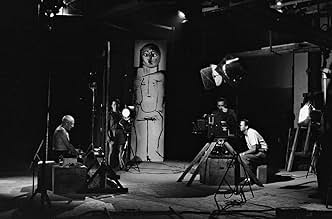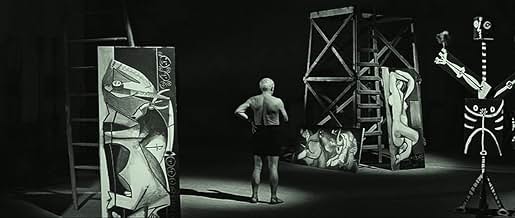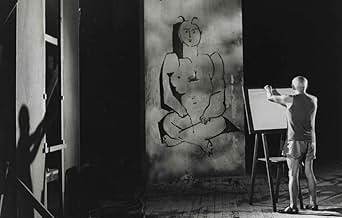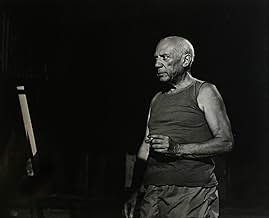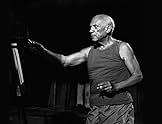VALUTAZIONE IMDb
7,5/10
2849
LA TUA VALUTAZIONE
Aggiungi una trama nella tua linguaA filmed record of Pablo Picasso painting numerous canvases for the camera, allowing us to see his creative process at work.A filmed record of Pablo Picasso painting numerous canvases for the camera, allowing us to see his creative process at work.A filmed record of Pablo Picasso painting numerous canvases for the camera, allowing us to see his creative process at work.
- Premi
- 1 vittoria e 1 candidatura in totale
Pablo Picasso
- Self
- (as Picasso)
Henri-Georges Clouzot
- Self
- (non citato nei titoli originali)
Claude Renoir
- Self
- (non citato nei titoli originali)
Recensioni in evidenza
9sol-
A fascinating look at the creative process, filmed in a unique fashion, using a clever technique to capture Picasso's work as he is painting without his hand or his brush getting in the way. This method is actually shown and explained during a live action sequence in the middle. Although the film is mostly just a set of different Picasso paintings in action, interactions between the film's director and Picasso are added in, which not only decreases tedium from the at times monotonous paintwork, but it also makes it a whole lot more interesting, as it feels as if we are there with Clouzot and Picasso in a film studio. The material still becomes a tad repetitive and it tires before the film is over, but set to some great music and actually showing Picasso working through his creative process, this is remarkable, one-of-a-kind film-making and definitely worth checking out.
This film reminds us that film is visual - very few words are spoken in Le Mystère Picasso. Instead, the camera just trains in canvas and white paper and watches Picasso create. It could have been boring, but instead it's hypnotic. One learns about the creative process without lecture!
Henri-Georges Clouzot, the French director of the masterpieces "Les Diaboliques" and "Le Salaire de la Peur" convinced his friend Pablo Picasso to make this documentary, painting twenty paints in front of the cameras. Using some special technique, Clouzot filmed from the other side of the canvas or stop-motion, and the result is this movie, where two geniuses are gathered: one behind and the other in front of the camera. In accordance with the information on the DVD, the canvases have been destroyed in the end of the shootings. Further, in 1984, the French government declared this documentary a national treasure. Clouzot and Picasso deserved this beautiful homage. My vote is eight.
Title (Brazil): "O Mistério de Picasso" ("The Mystery of Picasso")
Title (Brazil): "O Mistério de Picasso" ("The Mystery of Picasso")
If there was one word to describe this film for me, it would be "inspirational". And I think anyone who practices art or appreciates the process of art, can find this film enjoyable to watch. The film's title speaks for itself. We are engaged in an experimental documentary watching a prodigy at work and trying to unravel the magic of how it all happens. In the beginning there is a voice-over narrated introduction to the film, "Nobody knew what Rimbaud thought of when he wrote the poem "the drunk boat"." And then we realize that we are in for a real treat. Who would ever guess that the master of cubism would allow us to see his creative ideas at work? Most artists are very stubborn about this sort of thing, but then again most famous artists are also pretty ego-centric. The film places the camera behind a canvas that leaves the image transparent so that we can see the painting process without looking over the shoulder. There is a beautiful classical score along with this film and as the drawings progress, Picasso then takes on bigger challenges with paintings. The pacing is just right where the drawing process starts slow and then the strokes become faster with time-lapse photography. There is an amazing moment where the cameraman warns Picasso that he is about to run out of film. Picasso asks how many feet is left and calculates the timing of his painting and just at the last second, Picasso transforms the entire piece into something unexpected and radically different. We can see the spontaneity and playfulness in his work. The end is a mural shaped painting that evolves through many stages until Picasso says something like "its ruined. I have ruined the painting and yet at the same time, its improving." This is an indication of Picasso's fearless drive. When he paints, he is on fire. He works diligently for hours. Its fascinating to see little figures that he will paint over and over with more detail or more color. He wants to emphasize details that seem so ambiguous and its as if he's saying to the audience "look at this" "keep looking at this" "this is important." I first saw this film in the theater when I was about ten or twelve years old. I'm glad my family friends took me to see this. It has inspired me throughout the years. I saw the film again when I was twenty-four and it was just as I remembered it. After it was over, I did the same thing I did when I first saw the film; I pulled out a sketchbook and started drawing. This film is a real treat.
Henri-Georges Clouzot's The Mystery of Picasso starts by announcing that we will have the pleasure of entering the mind of Pablo Picasso, seeing how he gets his creative inspiration; the film promises us that the only way to do this is to watch Picasso's hand. Picasso paints on paper that the ink bleeds through, putting the camera on the other side of Picasso's canvas and watching the a reversed version painting appear in a seemingly magical way. It becomes clear early on that Clouzot is not wholeheartedly trying to show us how Picasso gets his inspiration; that is a mystery. Clouzot wants to capture the joy of painting. That's what makes this film so entertaining: watching bizarre, beautiful images appear out of nowhere. Sometimes Clouzot uses jump-cuts to show us the different phases of a work in progress at a rapid-fire velocity and then reverses the painting in the same jump-cut technique, deconstructing Picasso's. This is all scored to fiery jazz music. We also see Picasso while painting, as his painting is timed. (Picasso has a great screen presence). Clouzot is equally concerned with deconstructing Picasso's work to understand what makes this fast-working artist tick, showing how impossible that task is, and wowing us all the way through. As far as wowing goes, Clouzot did a pretty good job, with scenes that ranged from unforgettable to pleasantly surprising.
Lo sapevi?
- QuizSpecial transparent 'canvases' were constructed so that Pablo Picasso could paint on one side and 'Renoir, Claude' and Henri-Georges Clouzot could film the other.
- Citazioni
Pablo Picasso: I do not look for, I find!
- ConnessioniFeatured in Picasso (1985)
I più visti
Accedi per valutare e creare un elenco di titoli salvati per ottenere consigli personalizzati
- How long is The Mystery of Picasso?Powered by Alexa
Dettagli
- Data di uscita
- Paese di origine
- Lingua
- Celebre anche come
- The Mystery of Picasso
- Azienda produttrice
- Vedi altri crediti dell’azienda su IMDbPro
Botteghino
- Lordo Stati Uniti e Canada
- 267.836 USD
- Fine settimana di apertura Stati Uniti e Canada
- 19.143 USD
- 23 feb 1986
- Tempo di esecuzione
- 1h 18min(78 min)
- Colore
Contribuisci a questa pagina
Suggerisci una modifica o aggiungi i contenuti mancanti


